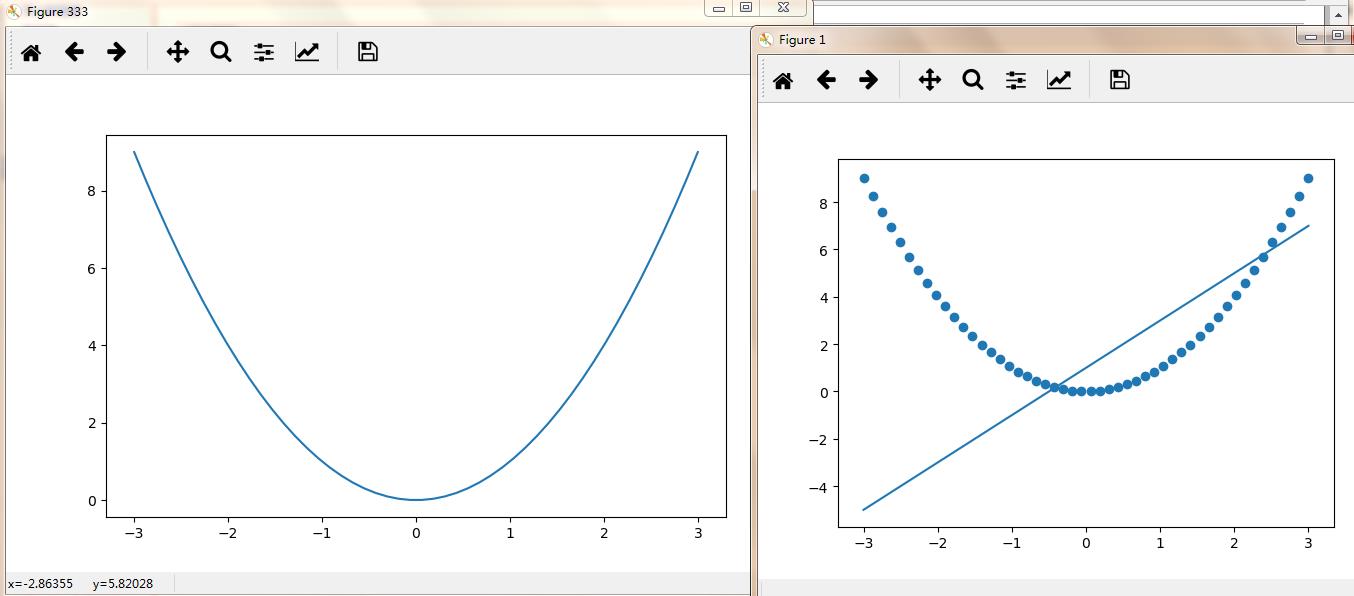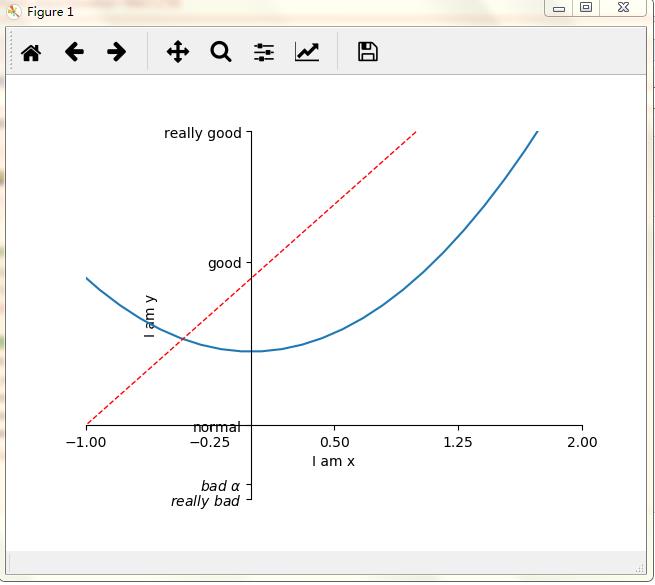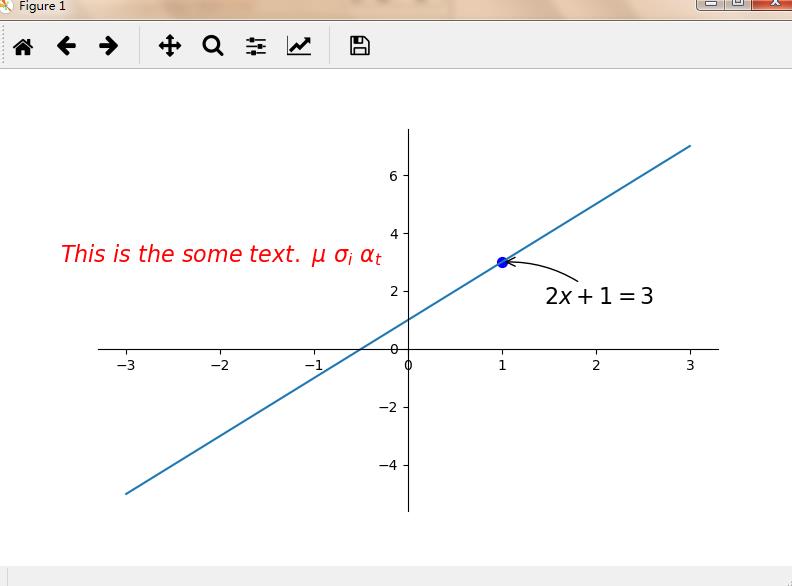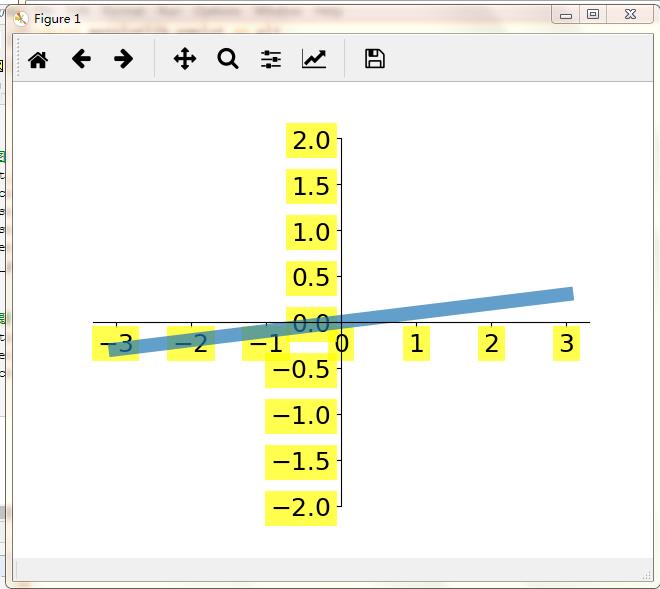python 可视化
Posted 蔡军帅
tags:
篇首语:本文由小常识网(cha138.com)小编为大家整理,主要介绍了python 可视化相关的知识,希望对你有一定的参考价值。
基本画图操作:
import matplotlib.pyplot as plt
import numpy as np
x = np.linspace(-3,3,50)
y1 = 2*x+1
y2 = x**2#x的平方
plt.figure()
plt.plot(x,y1) #画线
plt.scatter(x,y2) #画点
plt.figure(num=333,figsize=(8,5))#图333
plt.plot(x,y2)
plt.show()

设置图例:
import matplotlib.pyplot as plt
import numpy as np
x = np.linspace(-3,3,50)
y1 = 2*x+1
y2 = x**2#x的平方
plt.figure()
plt.xlim((-1,2))
plt.ylim((-2,3))
plt.xlabel(\'I am x\')
plt.ylabel(\'I am y\')
new_ticks = np.linspace(-1,2,5)#5为5个单位
print(new_ticks)
plt.xticks(new_ticks)
#用r(正则表达)和$框起来可以转换为计算机可以读的字体
#\\加空格转义为空格,\\加alpha能够输出 真正的alpha
plt.yticks([-2,-1.8,-1,1.22,3,],
[r\'$really\\ bad$\',r\'$bad\\ \\alpha$\',\'normal\',\'good\',\'really good\'])
l1,=plt.plot(x,y2,label=\'up\')#画线
l2,=plt.plot(x,y1,color=\'red\',linewidth=1.0,linestyle=\'--\',label=\'dowm\')#‘--’为虚线
#loc可以为upper right等等
#要传到handles要加,用了labels后就不用l1,l2本身的label
plt.legend(handles=[l1,l2,],labels=[\'aaa\',\'bbb\'],loc=\'best\')
plt.show()

设置坐标轴位置:
import matplotlib.pyplot as plt
import numpy as np
x = np.linspace(-3,3,50)
y1 = 2*x+1
y2 = x**2#x的平方
plt.figure()
plt.plot(x,y2)
plt.plot(x,y1,color=\'red\',linewidth=1.0,linestyle=\'--\')
plt.xlim((-1,2))
plt.ylim((-2,3))
plt.xlabel(\'I am x\')
plt.ylabel(\'I am y\')
new_ticks = np.linspace(-1,2,5)#5为5个单位
print(new_ticks)
plt.xticks(new_ticks)
#用r(正则表达)和$框起来可以转换为计算机可以读的字体
#\\加空格转义为空格,\\加alpha能够输出 真正的alpha
plt.yticks([-2,-1.8,-1,1.22,3,],
[r\'$really\\ bad$\',r\'$bad\\ \\alpha$\',\'normal\',\'good\',\'really good\'])
ax = plt.gca()#ax为上图
ax.spines[\'right\'].set_color(\'none\')#删除右边缘黑框
ax.spines[\'top\'].set_color(\'none\')#删除上边缘黑框
ax.xaxis.set_ticks_position(\'bottom\')#令x轴为底边缘
ax.yaxis.set_ticks_position(\'left\')#令y轴为左边缘
ax.spines[\'bottom\'].set_position((\'data\',-1))#将底边缘放到 y轴数据-1的位置
ax.spines[\'left\'].set_position((\'data\',0))#将左边缘放到 y轴数据-1的位置
plt.show()

标注:
import matplotlib.pyplot as plt
import numpy as np
x = np.linspace(-3,3,50)
y = 2*x+1
plt.figure(num=1,figsize=(8,5),)
plt.plot(x,y,)
ax = plt.gca()#ax为上图
ax.spines[\'right\'].set_color(\'none\')#删除右边缘黑框
ax.spines[\'top\'].set_color(\'none\')#删除上边缘黑框
ax.xaxis.set_ticks_position(\'bottom\')#令x轴为底边缘
ax.yaxis.set_ticks_position(\'left\')#令y轴为左边缘
ax.spines[\'bottom\'].set_position((\'data\',0))#将底边缘放到 y轴数据-1的位置
ax.spines[\'left\'].set_position((\'data\',0))#将左边缘放到 y轴数据-1的位置
#添加标注
x0 =1
y0 = 2*x0+1
plt.scatter(x0,y0,s=50,color=\'b\')#b代表blue
#plot(x列表,y列表)
plt.plot([x0,x0],[y0,y0],\'k--\',lw=2.5) #k代表黑色,lw为线宽
#model 1
#annotate标注
#xy为基准点
#textcoords=\'offset point\'代表以这个点为基准,标注在这个点的基础上x+30,y-30
#arrowprops描述箭头,线的弧度等信息
#xycoords=\'data\' xy的坐标是基于data的
plt.annotate(r\'$2x+1=%s$\' % y0,xy=(x0,y0),xycoords=\'data\',xytext=(+30,-30),
textcoords=\'offset points\',fontsize=16,
arrowprops=dict(arrowstyle=\'->\',connectionstyle=\'arc3,rad=.2\'))
#mothod 2
plt.text(-3.7,3,r\'$This\\ is\\ the\\ some\\ text.\\ \\mu\\ \\sigma_i\\ \\alpha_t$\',
fontdict={\'size\':16, \'color\':\'r\'})
plt.show()

(1)annotate语法说明 :annotate(s=\'str\' ,xy=(x,y) ,xytext=(l1,l2) ,..)
s 为注释文本内容
xy 为被注释的坐标点
xytext 为注释文字的坐标位置
xycoords 参数如下:
- figure points points from the lower left of the figure 点在图左下方
- figure pixels pixels from the lower left of the figure 图左下角的像素
- figure fraction fraction of figure from lower left 左下角数字部分
- axes points points from lower left corner of axes 从左下角点的坐标
- axes pixels pixels from lower left corner of axes 从左下角的像素坐标
- axes fraction fraction of axes from lower left 左下角部分
- data use the coordinate system of the object being annotated(default) 使用的坐标系统被注释的对象(默认)
- polar(theta,r) if not native ‘data’ coordinates t
extcoords 设置注释文字偏移量
| 参数 | 坐标系 |
| \'figure points\' | 距离图形左下角的点数量 |
| \'figure pixels\' | 距离图形左下角的像素数量 |
| \'figure fraction\' | 0,0 是图形左下角,1,1 是右上角 |
| \'axes points\' | 距离轴域左下角的点数量 |
| \'axes pixels\' | 距离轴域左下角的像素数量 |
| \'axes fraction\' | 0,0 是轴域左下角,1,1 是右上角 |
| \'data\' | 使用轴域数据坐标系 |
arrowprops #箭头参数,参数类型为字典dict
- width the width of the arrow in points 点箭头的宽度
- headwidth the width of the base of the arrow head in points 在点的箭头底座的宽度
- headlength the length of the arrow head in points 点箭头的长度
- shrink fraction of total length to ‘shrink’ from both ends 总长度为分数“缩水”从两端
- facecolor 箭头颜色
bbox给标题增加外框 ,常用参数如下:
- boxstyle方框外形
- facecolor(简写fc)背景颜色
- edgecolor(简写ec)边框线条颜色
- edgewidth边框线条大小
bbox=dict(boxstyle=\'round,pad=0.5\', fc=\'yellow\', ec=\'k\',lw=1 ,alpha=0.5) #fc为facecolor,ec为edgecolor,lw为lineweight
设置不透明度:
import matplotlib.pyplot as plt
import numpy as np
x = np.linspace(-3,3,50)
y = 0.1*x
plt.figure()
#alpha为设置不透明深度
plt.plot(x,y,linewidth=10,alpha=0.7)
plt.ylim(-2,2)
#建立坐标系
ax = plt.gca()#ax为上图
ax.spines[\'right\'].set_color(\'none\')#删除右边缘黑框
ax.spines[\'top\'].set_color(\'none\')#删除上边缘黑框
ax.xaxis.set_ticks_position(\'bottom\')#令x轴为底边缘
ax.yaxis.set_ticks_position(\'left\')#令y轴为左边缘
ax.spines[\'bottom\'].set_position((\'data\',0))#将底边缘放到 y轴数据-1的位置
ax.spines[\'left\'].set_position((\'data\',0))#将左边缘放到 y轴数据-1的位置
#解决线太粗把坐标挡住的问题
for label in ax.get_xticklabels() + ax.get_yticklabels():
label.set_fontsize(18)
label.set_bbox(dict(facecolor=\'yellow\', edgecolor=\'None\', alpha=0.7))
plt.show()

以上是关于python 可视化的主要内容,如果未能解决你的问题,请参考以下文章